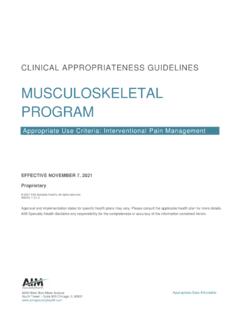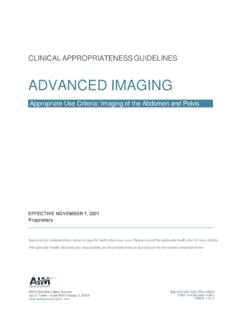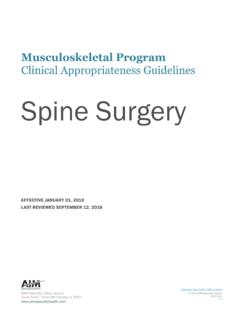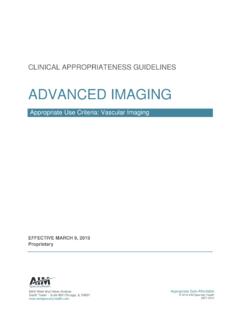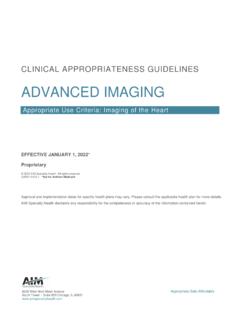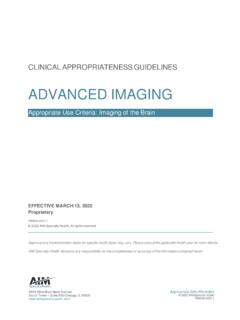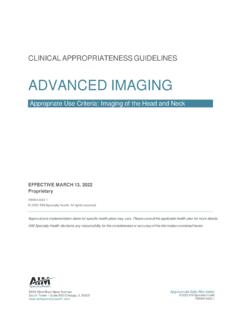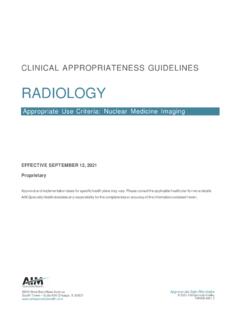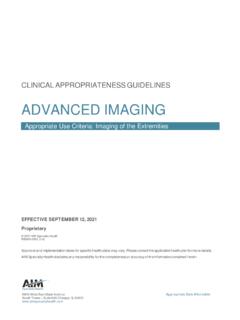Transcription of ADVANCED IMAGING - aimspecialtyhealth.com
1 8600 West Bryn Mawr Avenue South Tower Suite 800 Chicago, IL 60631 2017 2019 AIM Specialty Health 2057-0119 CLINICAL APPROPRIATENESS GUIDELINES ADVANCED IMAGING Appropriate Use Criteria: IMAGING of the Head and Neck EFFECTIVE JANUARY 1, 2019 Proprietary Head and Neck IMAGING Copyright 2019. AIM Specialty Health. All Rights Reserved. 2 Table of Contents Description and Application of the Guidelines .. 4 Administrative Guidelines .. 5 Ordering of Multiple Studies .. 5 Simultaneous Ordering of Multiple 5 Repeated IMAGING .. 5 Pre-Test Requirements .. 6 History .. 6 Head and Neck IMAGING .. 7 General Information/Overview .. 7 Scope .. 7 Technology Considerations .. 7 Definitions.
2 7 Clinical Indications .. 9 Congenital and Developmental Conditions .. 9 Infection and Inflammatory Conditions .. 9 Sinusitis/rhinosinusitis .. 9 Infectious disease not otherwise specified .. 11 Inflammatory conditions not otherwise specified .. 11 Trauma .. 12 Trauma .. 12 Tumor/Soft Tissue Mass .. 12 Cholesteatoma .. 12 Neck mass .. 12 Parathyroid adenoma .. 13 Thyroid nodule or thyromegaly (goiter) .. 13 Tumor not otherwise specified .. 14 Nasal Indications .. 14 Anosmia .. 14 Cerebrospinal fluid leak .. 14 Foreign body .. 14 Mucocele of the paranasal sinus .. 14 Nasal airway obstruction refractory to medical therapy .. 14 Nasal or sinus polyposis .. 14 Recurrent epistaxis .. 14 Orbital Indications.
3 14 Absence of red reflex (pediatric only) .. 15 Dysconjugate gaze .. 15 Exophthalmos or proptosis .. 15 Extraocular muscle weakness .. 15 Nystagmus .. 15 Head and Neck IMAGING Copyright 2019. AIM Specialty Health. All Rights Reserved. 3 Optic neuritis .. 15 Orbital pseudotumor .. 15 Papilledema .. 15 Strabismus .. 15 Thyroid ophthalmopathy .. 15 Temporomandibular Joint Pathology .. 15 Arthropathy of the temporomandibular joints .. 15 Frozen jaw .. 15 Juvenile idiopathic arthritis (Pediatric only) .. 15 Temporomandibular disease .. 16 Temporomandibular joint dysfunction .. 16 Miscellaneous 16 Cochlear implant .. 16 Foreign body evaluation .. 17 Laryngeal edema .. 17 Osseous lesions .. 17 Osteonecrosis of the jaw.
4 17 Salivary gland ductal calculi .. 17 Torticollis (Pediatric only) .. 17 Tracheal stenosis or upper airway obstruction .. 18 Signs and Symptoms .. 18 Dizziness or vertigo .. 18 Hearing loss .. 18 Hoarseness, dysphonia, and vocal cord weakness/paralysis .. 19 Horner s syndrome .. 20 Localized facial pain .. 20 Lymphadenopathy .. 20 Stridor .. 21 Tinnitus .. 21 Pulsatile tinnitus (Pediatric only) .. 21 Visual disturbance or visual field defect .. 22 References .. 22 Codes .. 24 History .. 24 Head and Neck IMAGING Copyright 2019. AIM Specialty Health. All Rights Reserved. 4 Description and Application of the Guidelines The AIM Clinical Appropriateness Guidelines (hereinafter the AIM Clinical Appropriateness Guidelines or the Guidelines ) are designed to assist providers in making the most appropriate treatment decision for a specific clinical condition for an individual.
5 As used by AIM, the Guidelines establish objective and evidence-based criteria for medical necessity determinations where possible. In the process, multiple functions are accomplished: To establish criteria for when services are medically necessary To assist the practitioner as an educational tool To encourage standardization of medical practice patterns To curtail the performance of inappropriate and/or duplicate services To advocate for patient safety concerns To enhance the quality of health care To promote the most efficient and cost-effective use of services The AIM guideline development process complies with applicable accreditation standards, including the requirement that the Guidelines be developed with involvement from appropriate providers with current clinical expertise relevant to the Guidelines under review and be based on the most up-to-date clinical principles and best practices.
6 Relevant citations are included in the References section attached to each Guideline. AIM reviews all of its Guidelines at least annually. AIM makes its Guidelines publicly available on its website twenty-four hours a day, seven days a week. Copies of the AIM Clinical Appropriateness Guidelines are also available upon oral or written request. Although the Guidelines are publicly-available, AIM considers the Guidelines to be important, proprietary information of AIM, which cannot be sold, assigned, leased, licensed, reproduced or distributed without the written consent of AIM. AIM applies objective and evidence-based criteria, and takes individual circumstances and the local delivery system into account when determining the medical appropriateness of health care services.
7 The AIM Guidelines are just guidelines for the provision of specialty health services. These criteria are designed to guide both providers and reviewers to the most appropriate services based on a patient s unique circumstances. In all cases, clinical judgment consistent with the standards of good medical practice should be used when applying the Guidelines. Guideline determinations are made based on the information provided at the time of the request. It is expected that medical necessity decisions may change as new information is provided or based on unique aspects of the patient s condition. The treating clinician has final authority and responsibility for treatment decisions regarding the care of the patient and for justifying and demonstrating the existence of medical necessity for the requested service.
8 The Guidelines are not a substitute for the experience and judgment of a physician or other health care professionals. Any clinician seeking to apply or consult the Guidelines is expected to use independent medical judgment in the context of individual clinical circumstances to determine any patient s care or treatment. The Guidelines do not address coverage, benefit or other plan specific issues. If requested by a health plan, AIM will review requests based on health plan medical policy/guidelines in lieu of the AIM Guidelines. The Guidelines may also be used by the health plan or by AIM for purposes of provider education, or to review the medical necessity of services by any provider who has been notified of the need for medical necessity review, due to billing practices or claims that are not consistent with other providers in terms of frequency or some other manner.
9 Head and Neck IMAGING Copyright 2019. AIM Specialty Health. All Rights Reserved. 5 Administrative Guidelines Ordering of Multiple Studies Requests for multiple IMAGING studies to evaluate a suspected or identified condition and requests for repeated IMAGING of the same anatomic area are subject to additional review to avoid unnecessary or inappropriate IMAGING . Simultaneous Ordering of Multiple Studies In many situations, ordering multiple IMAGING studies at the same time is not clinically appropriate because: Current literature and/or standards of medical practice support that one of the requested IMAGING studies is more appropriate in the clinical situation presented; or One of the IMAGING studies requested is more likely to improve patient outcomes based on current literature and/or standards of medical practice; or Appropriateness of additional IMAGING is dependent on the results of the lead study.
10 When multiple IMAGING studies are ordered, the request will often require a peer-to-peer conversation to understand the individual circumstances that support the medically necessity of performing all IMAGING studies simultaneously. Examples of multiple IMAGING studies that may require a peer-to-peer conversation include: CT brain and CT sinus for headache MRI brain and MRA brain for headache MRI cervical spine and MRI shoulder for pain indications MRI lumbar spine and MRI hip for pain indications MRI or CT of multiple spine levels for pain or radicular indications MRI foot and MRI ankle for pain indications Bilateral exams, particularly comparison studies There are certain clinical scenarios where simultaneous ordering of multiple IMAGING studies is consistent with current literature and/or standards of medical practice.
